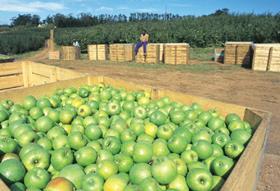
South Africa's topfruit and table grape production and exports are expected to fall considerably in the 2017/18 marketing year, due to the drought conditions seen in much of 2017.
This was the verdict of a new GAIN report by the US Department of Agriculture's Foreign Agricultural Service (USDA-FAS), which highlighted that below average winter rainfall and low dam levels in the Western Cape would severely impact the availability of irrigation water.
Apple production is forecast to decrease by 6 per cent to 850,000 tonnes, according to the USDA, due to the decrease in area harvested, limited irrigation water, lower yields and smaller fruit sizes.
Exports of apples for 2017/18 are expected to drop by 5 per cent to 500,000 tonnes, based on the available production and some fruit not meeting the export quality standards.
As of 2017, the UK remains the largest single export market for South Africa's apples, taking on just over 135,000 tonnes, followed by Malaysia (32,000 tonnes) and Bangladesh (31,000 tonnes).
It is anticipated that the country's pear production will also contract by 6 per cent to 405,000 tonnes, the USDA reported, resulting in about a 3 per cent decrease in 2017/18 exports to 250,000 tonnes.
The EU is South Africa`s traditional and leading export market accounting for about 49 per cent of total pear exports, followed by Asia (16 per cent), Africa (8 per cent) and the Middle East (5 per cent).
The USDA forecasts that 2017/18 table grape production in South Africa will decrease by 14 per cent to 287,000 tonnes, based on the decrease in area harvested and small fruit size in the Western Cape growing regions.
This decrease was partially offset by the higher yielding new generation varieties, as well as normal production and growing conditions in the Orange River growing regions.
As a result, the USDA predicted a 15 per cent decrease in table grape exports to 258,000 tonnes, with the EU accounting for some 75 per cent of those volumes historically.



